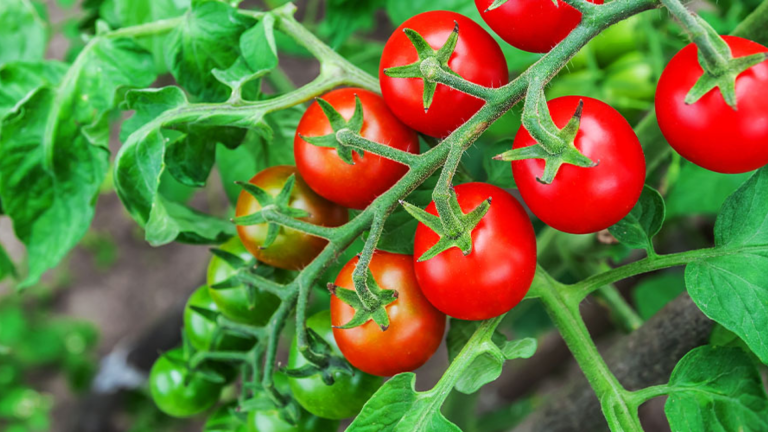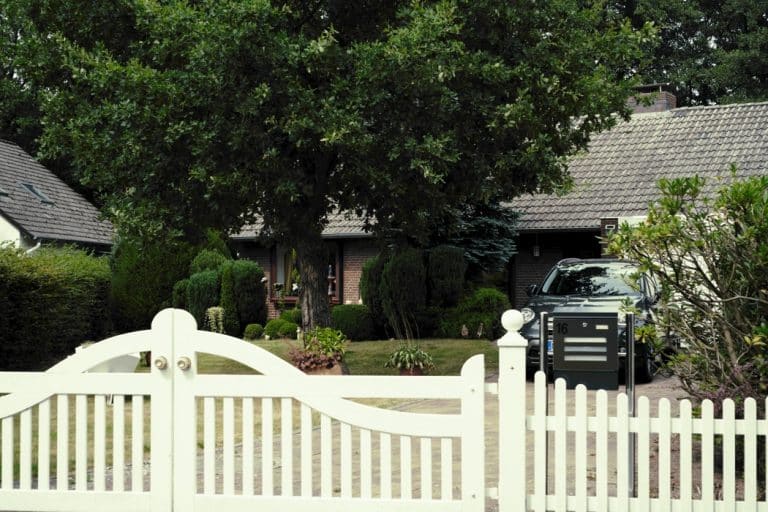Nothing tastes better than a tomato picked right off the vine in your own backyard. It’s fresh, juicy, and full of flavor that store-bought tomatoes just can’t match.
I’ve been growing tomatoes for years, and I’ve learned what really works through both success and mistakes.
If this is your first time planting a garden or you’ve tried growing tomatoes before and didn’t get great results, this guide will help you do better.
You’ll learn how to choose the right tomato types for your area, how to plant them the right way, and when it’s time to pick them. There are over 10,000 kinds of tomatoes, so there’s definitely one that will work well for your garden.
I’ve seen plants struggle and fail, but I’ve also seen them grow strong with just a few simple changes.
Follow these tips, and you’ll grow sweet, colorful tomatoes that taste better than anything from the store. Let’s get started!
Challenges Faced in Growing Tomatoes
Growing tomatoes can be a fun and rewarding project, but it’s not always simple. A lot of things can go wrong if you’re not prepared.
Tomatoes are very sensitive to temperature. They love warm weather, but if it gets too hot, the plants can suffer. Cold snaps can stop them from growing, and even one frost can kill them completely.
Watering is another tricky part. If you don’t give them enough, the plants get stressed, and the fruits may crack. But if you water too much, roots can rot, and diseases may grow in the wet soil.
Bugs also cause trouble. Hornworms can eat a plant down to the stem in just a few days. Aphids, spider mites, and whiteflies feed on the leaves and weaken your plants.
Then there are diseases like blight and powdery mildew. These can spread fast and are hard to stop once they start.
Best Ways to Grow Tomatoes
The following are the most effective techniques for growing abundant, delicious tomatoes. These methods work for gardens of any size. If you have acres of land or a few containers on a patio, these tips will help you grow better tomatoes.
1. Choose the Right Tomato Variety

Picking the right tomato for your garden matters more than most people think, because some types grow best in heat, while others prefer cooler weather.
Determinate tomatoes stay compact and produce most of their fruit at once, which is great if you’re short on space or want to make sauce. Indeterminate ones grow tall and produce for months but need strong support.
Look for disease-resistant labels like VFN on seed packets. New gardeners should try cherry types like Sun Gold or reliable slicers like Early Girl, which are easy to grow and give good harvests.
2. Start Seeds Indoors

Starting your seeds inside gives your plants a healthy head start, especially if your growing season is short.
Use seed-starting mix, which drains better than soil, and keep the mix damp but not soaked. Tomatoes sprout best in warm spots, so I either use heat mats or choose a sunny window. Once the seeds sprout, move them under grow lights for 14–16 hours a day.
When the first real leaves appear, transplant them to bigger pots, burying the stem deeper each time. Before planting outside, slowly expose the plants to outdoor weather for a week so they adjust.
3. Pick the Perfect Planting Spot

Tomatoes need full sun—at least 6 to 8 hours a day—with good airflow to reduce disease and help the leaves dry quickly after watering or rain.
Avoid planting where tomatoes or related plants like peppers or potatoes grew in the past few years, as leftover diseases in the soil can cause problems. In really hot areas, some afternoon shade can keep plants from dropping flowers during heat waves.
If you’re using containers, place them near a water source and in a spot where you can check and water them often during summer.
4. Amend the Soil Before Planting

Tomatoes need rich, well-drained soil to grow strong roots and healthy fruit, so always mix compost into the top 8–12 inches before planting.
The soil should be slightly acidic, with a pH between 6.0 and 6.8—home test kits make checking this easy. Add a balanced organic fertilizer or specific nutrients like bone meal for strong roots.
Avoid using heavy garden soil in containers—it holds too much water and often carries weed seeds or pests. If your soil drains poorly, like mine does, raised beds are a better choice because they keep roots from sitting in soggy spots.
5. Plant Deep for Strong Roots

Tomatoes are one of the few plants that grow roots from their stems, which means you can bury them deeper than most plants when transplanting.
Remove the bottom leaves and plant up to the top few sets, or lay tall seedlings sideways in a trench and gently turn the top upward. This creates a bigger root system, which helps the plant pull in more water and nutrients.
After planting, water deeply to settle the soil. In containers, leave space at the top for watering and wait to add mulch until the soil has warmed up.
6. Space Plants Correctly

Tomatoes need enough room to grow without competing for sunlight, nutrients, and air, so make sure to space them properly depending on the type.
Indeterminate types should be 2–3 feet apart, with rows about 3–4 feet apart, while determinate ones can be planted a little closer. Container tomatoes need large pots—at least 5 gallons for small types and 10 gallons for big ones.
Keep just one plant per container, plan your spacing with your support system in mind, if it’s cages or stakes, and don’t crowd your plants—tight spaces lead to weak growth and more disease.
7. Water Consistently and Deeply

Tomatoes need deep, regular watering to grow well, since uneven watering leads to problems like cracked fruit or blossom end rot.
Aim for 1–2 inches of water per week, either from rain or your hose. Water in the morning so leaves dry quickly, and focus on the soil, not the leaves, to avoid disease. Mulch helps keep moisture in and temperatures steady.
During hot, dry weeks, check the soil often—especially in containers. If it feels dry two inches down, it’s time to water again. Healthy watering habits lead to better fruit and fewer growing problems.
8. Mulch Around the Base

Mulch is an easy way to keep your tomato plants healthy by locking in moisture, stopping weeds, and reducing disease.
Spread 2–3 inches of mulch around the base, keeping it a few inches away from the stem to avoid rot. Straw and shredded leaves work great, while hay often brings unwanted weeds. Mulch stops dirt from splashing onto leaves during rain or watering, which helps prevent fungal diseases.
It also feeds the soil as it breaks down, making future planting seasons easier. In cooler climates, black plastic mulch can warm the soil but doesn’t add nutrients.
9. Use Tomato Cages Early

Tomatoes need support to stay upright and healthy, so I find it best and way more convenient to set up cages at planting time before the roots grow wide.
Determinate types do fine with standard cages, but indeterminate plants need taller, sturdier ones—homemade cages from wire mesh work well and hold up better in wind or heavy fruit loads.
Anchoring cages keeps them from tipping. Cages help keep fruit off the ground and improve airflow, which lowers the risk of disease. Trim the lower leaves to allow more airflow near the soil and to keep disease from spreading from splashed dirt.
10. Prune and Pinch Suckers Strategically

Pruning helps direct your tomato plant’s energy into growing fruit instead of too many leaves. Indeterminate tomatoes should be pruned more often—remove suckers that grow between the main stem and side branches, especially the ones below the first flower cluster.
Let some suckers grow above that point to keep a balance. Determinate types don’t need much pruning since too much can lower your harvest.
Always prune when it’s dry, preferably in the morning, so cuts heal faster. Removing the lowest leaves also helps keep plants dry and reduces the risk of soil-related disease.
11. Fertilize at the Right Time

Tomatoes need different nutrients at different growth stages, so feeding them at the right time makes a big difference.
Mix a balanced fertilizer into the soil when planting. Once flowers appear, I switch to one with less nitrogen and more phosphorus and potassium. This helps grow better fruit instead of just leafy growth.
Organic options like compost tea or fish emulsion are gentle and easy to use. Apply every few weeks as plants grow. Watch your plants—yellowing leaves may mean they need nitrogen, and purple ones can mean a lack of phosphorus. Adjust feeding based on signs.
12. Watch for Pests and Diseases

Tomatoes attract many pests and diseases, so check your plants regularly to catch problems early. Look under leaves for bugs like aphids, spider mites, and hornworms.
Hand-picking caterpillars works in small gardens, and insecticidal soap can help with smaller bugs. Keep plants healthy with good spacing, mulch, and watering at the base instead of the leaves. Remove any leaves with spots or signs of disease right away.
If you notice signs of blight or mildew, act fast—these spread quickly. A healthy routine and quick action can save your crop from bigger problems later.
13. Harvest at the Right Time

Harvesting tomatoes at the right time gives you the best taste and texture. Most turn color from the bottom up, and once they start changing, they can finish ripening indoors.
For best flavor, leave them on the plant until they’re full-colored and a little soft when squeezed. Pick tomatoes gently by twisting, not pulling, to avoid damage. If frost is coming, pick all full-sized green tomatoes and let them ripen inside.
Use a paper bag and a ripe banana to speed things up. Never refrigerate unripe tomatoes—it ruins the flavor and softens them too much.
Conclusion
Growing tomatoes takes time, care, and a bit of patience—but the reward of picking sun-warmed, juicy tomatoes from your own garden makes it all worth it.
There’s nothing quite like the taste of a homegrown tomato, and by following the steps in this guide, you’ll give yourself a strong chance at a successful harvest.
Gardening is both a science and an art, and every season gives you a chance to learn something new. Keeping a simple garden journal can help you remember what worked well and what didn’t in your own yard.
Try planting a few different tomato types each year to see which ones grow best in your soil and climate. You may find new favorites that surprise you.
Don’t get discouraged if one season is tough. Even the best gardeners deal with bugs, weather, and plant troubles sometimes.













